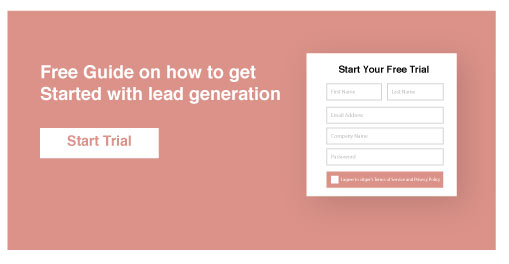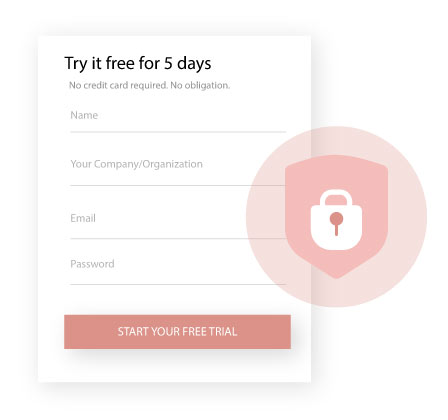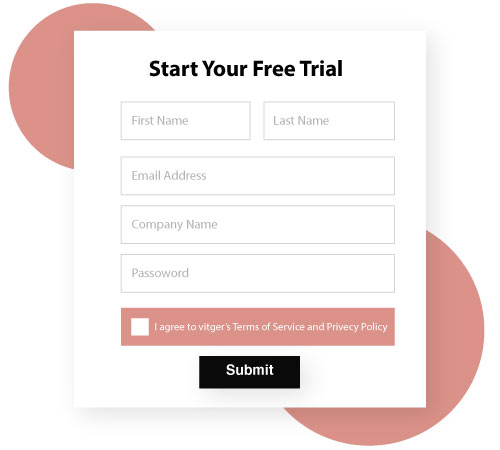A lead is a person or a firm that depicts some interest in your brand’s services or products. Acquiring new sales leads by generating the interest of potential customers is known as lead generation. It is one of the successful ways of running a business. It can help increase the sale of your services and products.
Lead forms are great tools that help you capture leads. These are online forms placed on your landing pages so that those visitors who are interested in your offer can opt into your mailing list. It collects info about them so that you can develop a business relationship with them.
This blog gives you a long list of lead form statistics and facts that tell you why you should not miss out on lead form from your digital marketing strategies in 2025.
Contents
Lead Form Statistics and Facts
Here are lead form statistics and facts related to leads, lead forms, lead generation, and lead management.
- 63% of businesses say that their biggest marketing challenge is generating web traffic and leads. Reasons are many, some of which aren’t in your control—for instance, customers who are not committed to purchasing due to year, finances, etc.
- A vast majority of marketers (85%) admit that their most important content marketing goal is lead generation.
- For generating leads, 53% of content marketers incorporate interactive content.
- In content marketing, one of the top three business objectives is lead generation (the other two are lead nurturing and sales). Leads can be generated by story-telling rather than by providing stats. For, people remember stories thirteen times more than they do stats.
- Blogs generate leads. 57% of businesses have witnessed this. This is because your leads like to get educated about your brand and the value it offers. So, if you are looking to increase your lead generation, start writing and posting blogs.
- 50% of marketers say that inbound marketing strategies, like lead forms, are their chief ways of acquiring leads.
- About 3/4th of companies (74%) use online forms for generating leads. Of these, 49.7% say that these forms bring them the highest conversion for lead generation.
- Only a quarter of the leads you generate are ready to proceed to sales.
- Generating outbound leads is 39% costlier than generating inbound leads. Even then, these are not as effective as the inbound leads.
- 79% of successfully running businesses have been employing marketing automation for lead generation for three years or more. This is because, the quicker the responses they get, the more is the likelihood that they buy from you.
- 80% of marketers employ automation software to get more leads. This is because one single follow-up is not enough to get the lead to buy; marketing automation software can be set to send follow-ups multiple times at the right intervals.
- 93% of people’s experiences online start with a search engine.
- While using a search engine, 70-80% of people do not pay any attention to paid ads. And 70% of the links they click on are organic.
- Though advertising on social media is expensive, it is very effective at generating leads and brand awareness. Businesses, therefore, allocate a high budget for social media marketing.
- When it comes to driving web traffic to content sites, search engines are 300% more effective than social media. This is because people seek a product or service on the search engine, whereas they are just browsing on social media.
- B2B marketers’ widely used social media platform is Twitter. 73% of business mentions happen here.
- The more landing pages your site has, the more leads you generate. So, get your site designer to make more landing pages for your site.
- Events bring in the most leads, stating 68% of B2B marketers.
- 50% of people admit that case studies are the propellants that launch them to move through the sales funnel.
- When compared to neglected leads, nurtured leads make more purchases. Lead nurturing, therefore, is a great way to increase sales opportunities. So, do look after your leads and guide them through the sales funnel.
- Among your target audience, 3% are purchasing actively, 40% are getting prepared to purchase, and 56% are not ready.
- The highest online purchasers are the generation of Millennials (generation Z or people born between 1981 and 1994). So businesses should study how their products or services can provide value to this generation of people and ensure that they are effectively marketing to them.
- While 55% of B2B professionals want to increase their number of leads, 68% of them desire to increase their lead quality.
- The biggest hindrance to generating more leads for 61% of businesses is the lack of resources like manpower, time, etc. If you are one such business, you can benefit from making use of NotifyVisitors’ lead generation form, with which you can target visitors based on their geo-location, cookies, time of day, web page visited, the device used, etc.
- To increase their lead generation, 58% of businesses have planned to allocate a higher budget.
- One out of every four marketers isn’t equipped with any knowledge about measuring the success of their efforts put toward lead generation.
- Of the details collected through lead forms, the most important form field as considered by 97% of B2B businesses is the Email address. The next two ranks are held by name (92%), and the firm (79%). No wonder, it is expected that 347.3 billion emails are expected to be sent each day by 2025.
- To part with their details through lead forms, companies offer freebies to visitors. The topmost winner freebies are webinars. Other winners include one-on-one product demos, e-books and whitepapers, and free trials.
- Though mobile traffic brings about almost half of all web activity, 45% of businesses are unsure about their mobile marketing efforts.
- As perceived by 95% of people, the largest hindrance to marketing success is gaining access to current customer data.
- 84% of firms state that employing a CRM system is beneficial for ascertaining lead quality. For, a CRM system identifies and categorizes leads to help you in this regard.
- By automating their lead management, firms witness a 10% increase in their revenue generation after 6-9 months.
Here ends our long list of lead form statistics and facts. Looking at these, one can say that lead forms are effective and here to stay. To reap the benefits of using lead forms, businesses and marketers need to know what works and what doesn’t so that they can come up with successful lead forms.
5 Essential Components of an Effective Lead Form
It is crucial to format and design your lead form in the right way to increase your conversion rates. So, read on to learn the five most vital components of effective lead forms.
1. The Positioning of the Lead Form

As you are well aware, lead forms are positioned on a landing page. Ensure that it is placed above the fold (on the top half of the web page) on the landing page. This way, its visibility will be increased. So, your viewers will be able to find it easily without manually scrolling down the page.
Further, to ensure that your offer is the main appeal of your lead form, you can put a picture of your offer next to the form. This will act as a pleasing reminder of what the visitor will get in return for parting with details about himself.
2. The Length of the Lead Form
Your form’s length is a crucial design factor that determines the quality and quantity of the leads you generate. By having a shorter form, you can generate more leads as more people will be ready to fill it out.
But by having a longer form, you will get better quality leads. This is because only those people who are willing to fill out more forms fields and part with more details about themselves and what they are interested in. So, shorter forms bring more leads, and longer forms bring fewer but better quality leads.
Therefore, the ideal length of your form should strike a perfect balance between gathering sufficient information and not demanding a lot of information that they’re not ready to part with.
3. The Form Fields

You need to know what and how much information you should ask for. Aim at gathering sufficient details to enable you to both qualify and contact the lead. And refrain from asking for loads of details that make them feel exhausted and exit your page.
Your lead-qualifying fields should be questions and forms that will help you determine the strength of the lead. That is their likelihood of becoming your customer. So, these can include fields like website, company, job role, and the number of employees; and questions that help you determine their need for your services and products.
Your contact fields should be those asking for their name and email address. These will help you follow up and take them through the sales funnel to make them your customers.
4. Your Privacy Policy

Security is one of the biggest concerns of people while filling out forms. Most of them experience some kind of uneasiness when they are asked to part with sensitive information online. You need to let your visitors know that their information will be safe with you.
For this, you should have your privacy policy link near the field where visitors are expected to provide their email id. You also need to display your logo and some kind of third-party security certification, guarantee seal, or authority endorsement around this area.
Also, ensure that your site looks credible. This will reduce the potential friction that your prospects face while filling out your form.
5. The Submission Button

The final component of your form, which the prospect has to press to send it to you after its completion, is the “Submit” button. Rather than going for the commonly found text “Submit”, use some other variation. Studies say that it brings lower conversions than other wordings. This is due to the bore and sense of commitment requirement associated with it.
So, choose your Submit button text wisely. Words like “Click Here” and “Go” are said to perform well. “End”, “Send”, “Approve”, etc. are other options. Rounding it all up, lead form statistics and facts for 2025 point out that lead generation is the biggest concern for many businesses and marketers. And that lead forms can help effectively in this regard. However, you need to take good care while designing and formatting your lead form. Hope our blog provided you with useful info in this regard.
Read more:

























 Email
Email SMS
SMS Whatsapp
Whatsapp Web Push
Web Push App Push
App Push Popups
Popups Channel A/B Testing
Channel A/B Testing  Control groups Analysis
Control groups Analysis Frequency Capping
Frequency Capping Funnel Analysis
Funnel Analysis Cohort Analysis
Cohort Analysis RFM Analysis
RFM Analysis Signup Forms
Signup Forms Surveys
Surveys NPS
NPS Landing pages personalization
Landing pages personalization  Website A/B Testing
Website A/B Testing  PWA/TWA
PWA/TWA Heatmaps
Heatmaps Session Recording
Session Recording Wix
Wix Shopify
Shopify Magento
Magento Woocommerce
Woocommerce eCommerce D2C
eCommerce D2C  Mutual Funds
Mutual Funds Insurance
Insurance Lending
Lending  Recipes
Recipes  Product Updates
Product Updates App Marketplace
App Marketplace Academy
Academy

